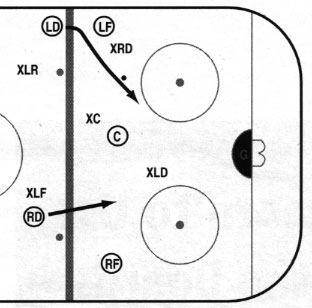|

|
 |
Offense
 |
| Figure 1 |
Passing is the quickest way to move the puck up the rink to setup your offensive attack. But what do you do when all your forward (or lateral) passing lanes are blocked? If you can skate with the puck to an open area, then do so. But if you're just skating into traffic, what else can you do to keep your offensive play moving? If you have been watching any recent pro games, then you would see an increase in the number of teams that use their defensemen to incorporate a safe and effective offensive passing outlet.
Although their title (defensemen) may seem to imply a one-dimensional position, the D must also be used in all areas of your offensive game if you are going to become the best you can be. Three uses of the defensemen outlet pass occur when your team is breaking out of its own zone, in the neutral zone, and when breaking into your offensive zone.
Breaking Out
As your team begins to break out of its defensive zone, there are times when the opposing team tries to exert extra pressure on you through various forechecking techniques. The best way to not turnover the puck in your own zone is to pass the puck back to one of your defensemen.
This defensemen outlet pass does several things for your offensive attack: It temporarily relieves the pressure that the attacking team is putting on you; it puts the puck into a safe location and allows your team to maintain control of the puck; and third, it gives your team time and options to continue your offensive attack.
 |
| Figure 2 |
In Figure 1, the left forward (LF) reads that he is covered by XRF and that a pass to the center (C) could be intercepted by XLF. The best play in this situation is to get the puck back to your defensemen (the left defenseman in this case) and then LD can move the puck to RD to open up the play a bit.
Now some of you coaches (and players) may be saying that you should never pass the puck in front of your net. If you are dealing with novice players and teams, then that should be your rule; if you are dealing with players who have played together for awhile, then you can incorporate that tactic as long as there are no opponents in the vicinity of RD who could get control of the puck. For those teams choosing not to pass the puck in front of your net, your option should be to dump the puck along the boards behind your net so that RF can get it and start to move with it.
Through The Middle
Once you’ve got the puck moving toward the neutral zone, the same tactic can be used to keep your momentum going. In Figure 2, RF is moving up the right side of the rink when she encounters pressure from both XLD and XLF. The best tactical solution is to make the outlet pass to your defenseman (RD in this case). RD can then move the puck to LD, again., allowing the puck to be moved to a safe location and the time for the offensive progression to continue.
 |
| Figure 3 |
Breaking In
If your break-in play is meeting with some resistance from one of their defensemen (XRD in this example), then your defensemen have the opportunity to become crucial contributors to your offensive attack. In Figure 3, LF is trying to squeeze along the boards past XRD but reads that XRD has the angle on him. He also reads that C is being covered. LD lets him know that he is open and LF drops the puck back to LD who can now skate with the puck toward the net. Usually in this situation, LD will draw a crowd of two or sometimes even three defenders who are all trying to cover him. Just before LD gets covered, he should move the puck to C or RF and let them shoot or skate with the puck in on net.
So when your passing lanes are blocked and you cannot skate with puck to move your offensive attack forward, use your defensemen and incorporate an outlet pass to them to keep your offensive play moving in the right direction.
This first appeared in the 03/1998 issue of Hockey
Player Magazine®
© Copyright 1991-2003, Hockey Player® LLC and Hockey
Player Magazine®
Posted: Feb 8, 2003, 17:50
Top of Page
|
|
 |

|